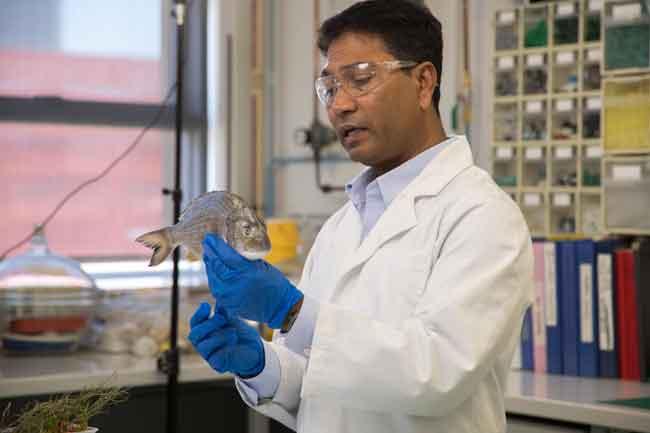

Published on the 25th January 2019 by ANSTO Staff
Quality fish production, traceability, food safety and sustainable, eco-friendly industries were the main themes of a major Asian aquaculture conference held in Thailand late last year.

Dr Debashish Mazumder (pictured above), who is leading ANSTO’s Aquatic Ecosystems project and food provenance research in association with internal and external collaborators, presented at the conference about ANSTO’s capabilities in this area. Over 200 representatives from 25 countries attended to hear about the latest development relating to key issues in seafood production, sustainability and quality authentication.
“Aquaculture is one of the fastest growing food production sector and nearly 90% of the global production comes from Asia and Australia is a major importer of these products,” said Mazumder.
“There was a great deal of interest in the tools and techniques we are using with our partner UNSW and DPI Fisheries, NSW to make the aquaculture industry more sustainable, the farming of seafood more cost efficient and environmentally sustainable, and also contribute to measures to enhance food safety to determine the source of origin of seafood,” said Mazumder.
“Our approach has the potential to bring benefits that work both ways, for the producers and the buyers with the ultimate benefit going to the consumer,” said Mazumder.
Building on partnerships with universities and industry bodies in Australia, ANSTO is now looking to consolidate relationships in Asia-pacific and beyond.
“It is important for several reasons. We can provide overseas organisations with the tools and expertise to have to improve and grow their industries but also set up those links that give us access to data on fish production from specific areas and local water. This information can be used to benefit Australian business while protecting human health, guaranteeing sustainability, reducing or preventing food fraud, and minimising biosecurity risks associated with global movement of raw fish products,” explained Mazumder.
He was referring to the isotopic and elemental signatures that are found in the fish and their environment that enable researchers to pinpoint origin, when combined with other nuclear techniques and mathematical models. “The reason that isotopic signatures are so powerful is that they are unique to the species and its habitat,” said Mazumder.
Although Thailand has undertaken food authenticity research on rice and honey, it has yet to apply it to its fisheries industry, which is essential to both its food security and economy.
There were also expressions of interest in the techniques from researchers from Australia, the US, Malaysia, Thailand, Bangladesh and Turkey.
While in Southeast Asia, Mazumder visited the Thailand Institute of Nuclear Technology (ANSTO’s counterpart), and presented an overview of ANSTO’s research on sustainable seafood production research on high value fish species using nuclear techniques.
“Interestingly, my colleague in Turkey wanted to explore if the techniques could be used on the copper based paint for marine cage aquaculture applications,” said Mazumder.
An American colleague who works in southeast Asia was interested a possible application on tilapia. Some American consumers find the farmed fish unpalatable based on a misperception that they are foul smelling because they absorb poultry manure applied for tilapia production in local waters.
“I was able to point out that our studies had shown that the fish do not assimilate manure from their surroundings at all.”
ANSTO is one of only a few organisations in the world that is pioneering the use of nuclear techniques to address questions of sustainable seafood production and food provenance to complement regulations, certification and traceability protocols.

